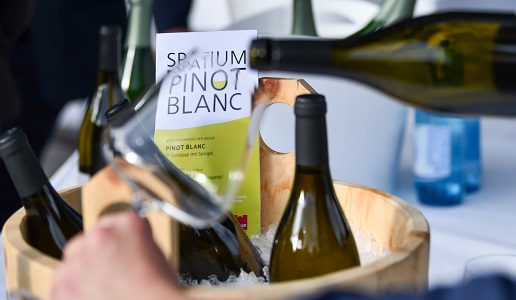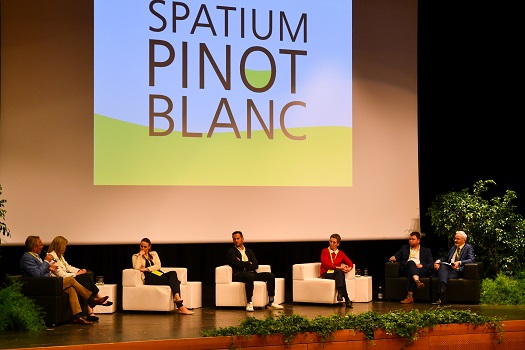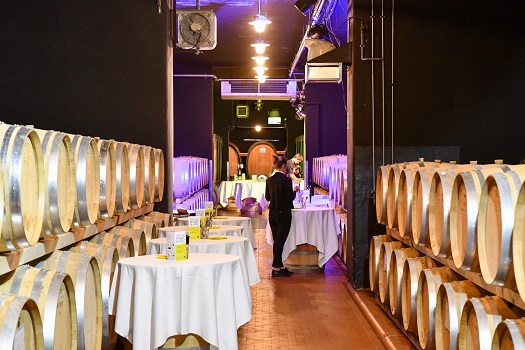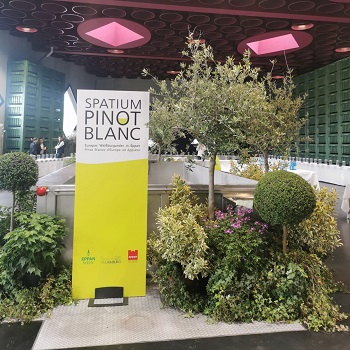Spatium Pinot Blanc

Pinot Blanc makes its way from South Tyrol in a two-day event, May 18 and 19, featuring scientific seminars and tastings.
That South Tyrol is becoming the Pinot wine region is a suspicion I have begun to have for a while. Confirming this are the numbers of hectares, but more importantly, the energy that grape and wine producers pour into communicating and promoting these grape varieties and wines.
To be fair, the most represented in terms of hectares is Pinot Grigio. Official data attribute as many as 669 hectares to it, which corresponds to 12 percent of the total production in Alto Adige making it the most cultivated grape variety with excellent yields. Italian Pinot Grigio is world famous, immediate and easy to understand. It meets with the approval of most, proves versatile and satisfying yet undemanding, even in price. For these and other reasons it is in demand, and will continue to be so. It must be said, however, that Alto Adige does not hold the exclusivity of this grape variety or the primacy. Widely planted in Veneto, Friuli Venezia Giulia and Trentino it is obviously considered unrepresentative, consequently he could not be the Pinot of reference for Alto Adige.
 Different kettle of fish when it comes to Pinot Noir, 522 hectares or 9.3% of production. Obviously different yields and a zoning project that is beginning to show results. Representative of the territory, certainly, and increasingly recognizable.
Different kettle of fish when it comes to Pinot Noir, 522 hectares or 9.3% of production. Obviously different yields and a zoning project that is beginning to show results. Representative of the territory, certainly, and increasingly recognizable.
We come then to the third Pinot, the white one. A variety that sometimes competes, and more often than not shoulders, with Chardonnay. There are 579 hectares under Pinot Blanc, which corresponds to 10.3%. For the record Chardonnay: 592 ha, 10.6%; until 1999 there was no distinction between these two varieties.
In Pinot Blanc, the South Tyrolean identity is stronger and more pronounced. It loves altitude, and in Alto Adige that is not lacking. Apparently he is the white grape variety, removed from Chardonnay, in which to invest and grow. In its aromatic neutrality (to understand this statement think of the recognizability of Sauvignon and Gewürztraminer) it is very versatile lending itself to different interpretations. From vinification in steel for vintage wines, we move on to more complex versions that ferment in wood and mature for a long time on yeasts. Let's not forget, of course, that it also lends itself to bottle refermentation and the classic method. In the vineyard it is susceptible to rot, consequently it prefers ventilated vineyards with proper insolation and where water stagnation is averted.
 Ventilation seems to be precisely the secret ingredient contributing not only to the healthiness of the grapes but especially to the balance in ripening between sugars, acids and aromas. Essential aspects in determining the style of Pinot Blanc that can be produced. In fact, this is what emerged from an interesting study by the Laimburg Experimentation Center that looked at Pinot Bianco from four different areas, Tramin, Nals, Eppan and Terlan, sampling grapes for each from two different altitudes (223-730 m asl for Tramin. 650-419 for Nals. 542 and 569 for Eppan. 278 and 670 for Terlan).
Ventilation seems to be precisely the secret ingredient contributing not only to the healthiness of the grapes but especially to the balance in ripening between sugars, acids and aromas. Essential aspects in determining the style of Pinot Blanc that can be produced. In fact, this is what emerged from an interesting study by the Laimburg Experimentation Center that looked at Pinot Bianco from four different areas, Tramin, Nals, Eppan and Terlan, sampling grapes for each from two different altitudes (223-730 m asl for Tramin. 650-419 for Nals. 542 and 569 for Eppan. 278 and 670 for Terlan).
The choice of production site conditions, not to say determines, the style (not the quality) of the grapes and consequently the wines by affecting ripeness and the relationship between ripeness and harvest time. In a nutshell, altitude and temperature are the two factors to be monitored. Temperature in particular has proven to be an interesting and by no means trivial statistic. By temperature we mean an average between those of soil, clusters, and air; all obviously affected by the presence of wind. An interesting conclusion was that where the average temperature is high the time of harvest does not particularly affect the final result, while where the summation is lower the time of harvest becomes decisive and we can realistically speak of early harvest, ripening and late harvest. It also seems that this grape variety responds resiliently to climate change, however, its fate is altitude and perhaps for future plantings it is good to even think about going up in altitude.
 This should come as no surprise considering that the grape variety is currently most represented in Germany, which is much further north than Italy and has a very cool climate, with 5580 hectares. Italy follows with 2337 hectares mainly in Trentino Alto Adige, Friuli Venezia Giulia, Lombardy and Veneto. Then Austria, 1872 hectares, and a wooden medal for France with 1200-1300 hectares.
This should come as no surprise considering that the grape variety is currently most represented in Germany, which is much further north than Italy and has a very cool climate, with 5580 hectares. Italy follows with 2337 hectares mainly in Trentino Alto Adige, Friuli Venezia Giulia, Lombardy and Veneto. Then Austria, 1872 hectares, and a wooden medal for France with 1200-1300 hectares.
On a general level we can say that Pinot Bianco as a wine is appreciated in Italy and abroad for its aromas, beautiful freshness and drinking ability. Versatile not only in the cellar but also at the table - it lends itself to various pairings - it is presumable that over the years it will increase its name and also the demand outside the South Tyrolean public, which in fact already prefers it most of the time. Alongside the companies, the contribution of trained sommeliers and waiters in promoting it at the table will be decisive, this we already know but we never tire of repeating.
In conclusion, the statement at the close of the panel discussion on the state of Pinot Blanc by Hans Terzer was significant. The winemaker emphasized how important it will be in the future to identify the most suitable areas for growing each varietal and how this will lead to a specialization of the winemakers themselves. Having to necessarily make all the labels possible is not a legal requirement, becoming number one in something, on the other hand, could prove a turning point for both social wineries and individual small producers. In short, long live Pinot Blanc, certainly, but also the scientific research that will undoubtedly help to deal in the best possible way with climate change while protecting and respecting the environment and its inhabitants.
The following are some tastings that impressed me. The designation of course is Alto Adige Pinot Bianco Doc, which sounds Südtyrol Weissburgunder in German. Click on the wine name to open the tab.
- Kellerei St. Michael-Eppan, Alto Adige Pinot Bianco St. Valentin 2021
- Kellerei Schreckbichl Colterenzio, Alto Adige Pinot Bianco Riserva Berg 2021 (Anteprima)
- Castelfeder, Alto Adige Pinot Bianco Riserva Tecum 2020
- Klaus Lentsch, Alto Adige Pinot Bianco Riserva Weissberg 2020
- Weingut Hans Rottensteiner, Alto Adige Pinot Bianco Carnol 2022
Related Products
| Product | Producer | Date of publication | Author | Read | |
|---|---|---|---|---|---|

|
Pinot Bianco Sanct Valentin 2021
Alto Adige |
Cantina San Michele Appiano | 06/09/23 | Sissi Baratella | |

|
Cantina San Michele Appiano
|
11/11/11 | Redazione |
If Alto Adige wines are now known and respected throughout the world much of the credit goes to this estate and its historic kellermeister Hans Terzer. This is where the revolution began to uproot... Leggi tutto |
|

|
Pinot Bianco Berg 2021
Alto Adige |
Cantina Colterenzio / Schreckbichl | 06/09/23 | Sissi Baratella | |

|
Cantina Colterenzio / Schreckbichl
|
06/25/13 | Redazione |
Schreckbichl has become a monument in the winemaking history of Alto Adige and Italy, as demonstrated by the Sauvignon and Cabernet Sauvignon of the Lafoa line, which are universally recognized as... Leggi tutto |
|

|
Pinot Bianco Tecum 2020
Alto Adige |
Castelfeder | 06/09/23 | Sissi Baratella | |

|
Castelfeder
|
06/10/22 | Redazione | ||

|
Pinot Bianco Weissberg 2020
Alto Adige |
Klaus Lentsch | 06/09/23 | Sissi Baratella | |

|
Klaus Lentsch
|
06/09/23 | Redazione | ||

|
Pinot Bianco Carnol 2022
Alto Adige |
Rottensteiner | 06/09/23 | Redazione | |

|
Rottensteiner
|
04/18/18 | Redazione |

 Italiano
Italiano







